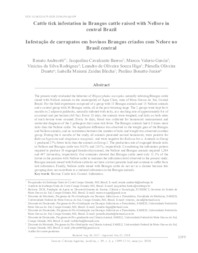Cattle tick infestation in Brangus cattle raised with Nellore in central Brazil.
Cattle tick infestation in Brangus cattle raised with Nellore in central Brazil.
Autoria: ANDREOTTI, R.; BARROS, J. C.; GARCIA, M. V.; RODRIGUES, V. da S.; HIGA, L. de O. S.; DUARTE, P. O.; BLECHA, I. M. Z.; BONATTE-JUNIOR, P.
Resumo: The present study evaluated the behavior of Rhipicephalus microplus naturally infesting Brangus cattle raised with Nellore animals in the municipality of Água Clara, state of Mato Grosso do Sul, Central Brazil. For the field experiment composed of a group with 15 Brangus animals and 15 Nellore animals and a control group with 30 Brangus cattle, all at the post-weaning stage. The 2 groups were kept for 6 months in 2 adjacent paddocks, naturally infested with ticks, at a stocking rate of approximately 0.6 of an animal unit per hectare (AU/ha). Every 18 days, the animals were weighed, and ticks on both sides of each bovine were counted. Every 36 days, blood was collected for hematocrit measurement and molecular diagnosis of the 3 pathogens that cause tick fever. The Brangus animals had 6.8 times more ticks than the Nellore cattle. No significant difference was observed in the weight gain of the Brangus and Nellore animals, and no correlation between the number of ticks and weight was observed in either group. During the 6 months of the study, all animals presented normal hematocrit, were positive for Babesia bigemina and Anaplasma marginale, and were negative for Babesia bovis. Animals in Group 1 produced 27% fewer ticks than the animals in Group 2. The production rate of engorged female ticks in Nellore and Brangus cattle was 0.83% and 2.01%, respectively. Considering the infestation pattern required to produce 10 engorged females/day/animal, the Nellore and Brangus animals required 1,204 and 497 larvae/day, respectively. Our estimates showed that Brangus cattle need only 11.3% of the larvae in the pastures with Nellore cattle to maintain the infestation level observed in the present study. Brangus animals raised with Nellore cattle do not have a lower parasitic load and continue to suffer from tick infestation. Finally, Nellore cattle raised with Brangus cattle do not act as a cleaner because this grouping does not contribute to a reduced infestation in the Brangus animals. Key words: Bovine. Cattle tick. Control. Infestation.
Ano de publicação: 2018
Tipo de publicação: Artigo de periódico
Unidade: Embrapa Gado de Corte
Palavras-chave: Bovine, Bovino, Carrapato-do-boi, Cattle tick, Control, Infestation, Infestação
Observações
1 - Por padrão são exibidas publicações dos últimos 20 anos. Para encontrar publicações mais antigas, configure o filtro ano de publicação, colocando o ano a partir do qual você deseja encontrar publicações. O filtro está na coluna da esquerda na busca acima.
2 - Para ler algumas publicações da Embrapa (apenas as que estão em formato ePub), é necessário ter, no celular ou computador, um desses softwares gratuitos. Sistemas Android: Google Play Livros; IOS: iBooks; Windows e Linux: software Calibre.
Acesse outras publicações
Acesse a Base de Dados da Pesquisa Agropecuária (BDPA) para consultar o acervo completo das bibliotecas da Embrapa.

